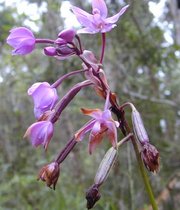Carpel
|
|
- Not to be confused with carpal, a foot-bone.
A carpel is the female reproductive organ of a flower; the basic unit of the gynoecium. The parts of the carpel are:
- the stigma, a receptive (usually sticky) area to which pollen grains (male gametes) adhere once delivered there by a pollinating agent;
- the style, a stalk connecting the stigma with the ovary below; and
- the ovary (also also called a megasporophyll) containing the female reproductive cell or ovule.
The carpel (if single) or carpels (if fused) comprise the pistil of the flower. A flower with two or more fused carpels (called a compound ovary or compound pistil) is termed syncarpous. However, if the gynoecium consists of more than one distinct carpel, it will have more than one pistil and is then termed apocarpous. Apocarpous also pertains to any flower with a single carpel. Fertilization of the ovule or ovules results in development of the carpel(s) into a fruit.
The gynoecium is the innermost whorl of the parts of a flower, and in many flowers the other parts (sepals, petals, and stamens) are attached to the receptacle beneath the gynoecium. In such cases, where the ovary lies above the attachments of the other distinct floral parts, the flower is described as hypogynous or as having a superior ovary. In some species (examples include plum, cherry, and blackberry), the other (noncarpellary) floral parts are fused to form a cup called a floral tube or calyx tube. In these flowers, the ovary lies physically lower than the lobes of the sepals and petals and below the point of attachment of the stamen filaments — the ovary is still considered to be superior but the flower is termed perigynous..
In those flowers in which the floral tube is fused with the ovary, the sepals, petals, and stamens appear to grow out from the top of the ovary, and the flower is said to be epigynous and have an inferior ovary. Examples of plant families with inferior ovaries include orchid, sunflower, and cactus. The position of the ovary is an important consideration in the identification and classification of plant species, as well as the kind of fruit that develops after fertilization.
Carpel anatomy
The carpel of a simple apocarpous gynoecium appears as a folded structure, differentiated into a basal fertile part (ovary) and an upper sterile part (style). Various interpretations of the origin from a leaf-like structure have been made (Esau, 1965), but the important anatomical description is that of a variously folded tissue surrounding a cavity (called a locule) within which projects one or more ovules, attached by or along a placenta. Typically, a carpel has two placentae. An example of a simple carpel is that of a pea or bean: the fruit develops from the single carpel consisting of two rows of ovules aligned beside one another along the placental margin.
The union of two or more carpels (syncarpy) may be observable as part of the ontogeny (flower development) or the compound pistil may simply develop as a unit structure (a congenitally fused pistil) to be interpreted as an aspect of the phylogeny (evolutionary history). In a compound pistil, the carpels are fused together in one of two basic ways:
- the carpels are fused at or near their margins (parietal placentation), usually forming a single large cavity — an example would be the violet.
- the folded carpels extend in towards the center, being fused along their outer faces (laterally concrescent), with the placentae arranged around a central column of tissue (axile placentation). There may be as many locules as there are carpels; and tissue of the receptacle may be involved in forming the axillary column. An example of axile placentation would be the lily.
A complicating factor in all of this is the fact that in some species syncarpy is present only at the base of the carpels, the pistil being apocarpous in the upper part. The manner of fusing of the carpels can also vary from one part of the pistil to another.
The ovule
The ovule, which represents the megasporangium, when mature, consists of one or two coats surrounding the central nucellus, except at the apex where an opening, the micropyle, is left. The nucellus is a cellular tissue enveloping one large cell, the embryo-sac or megaspore. The germination of the megaspore consists in the repeated division of its nucleus to form two groups of four, one group at each end of the embryo-sac. One nucleus from each group, the polar nucleus, passes to the centre of the sac, where the two fuse to form the so-called definitive nucleus. Of the three cells at the micropylar end of the sac, all naked cells (the so-called egg-apparatus), one is the egg-cell or oosphere, the other two, which may be regarded as representing abortive egg-cells (in rare cases capable of fertilization), are known as synergidae. The three cells at the opposite end are known as antipodal cells and become invested with a cell-wall.
References
- Esau, K. 1965. Plant Anatomy, 2nd Edition. John Wiley & Sons. 767 pp.de:Fruchtblatt

